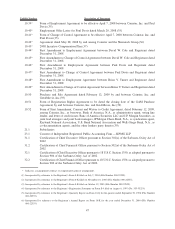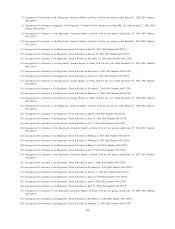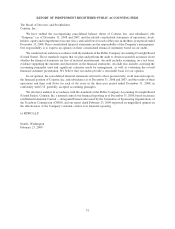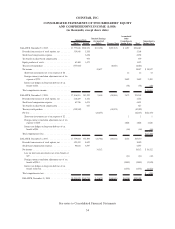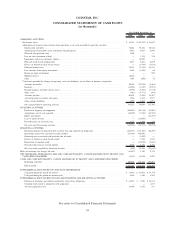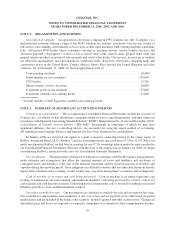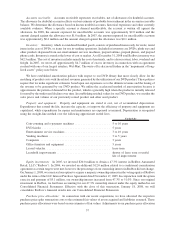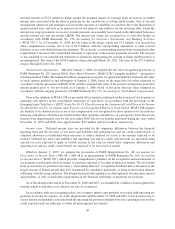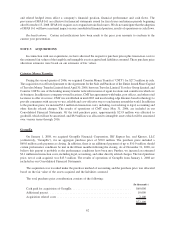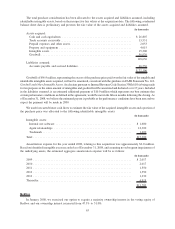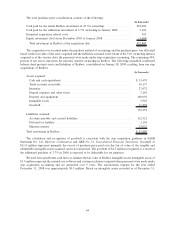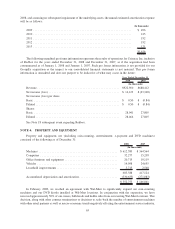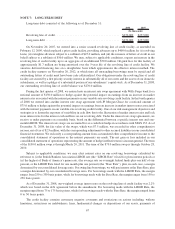Redbox 2008 Annual Report Download - page 59
Download and view the complete annual report
Please find page 59 of the 2008 Redbox annual report below. You can navigate through the pages in the report by either clicking on the pages listed below, or by using the keyword search tool below to find specific information within the annual report.
Accounts receivable: Accounts receivable represents receivables, net of allowances for doubtful accounts.
The allowance for doubtful accounts reflects our best estimate of probable losses inherent in the accounts receivable
balance. We determine the allowance based on known troubled accounts, historical experience and other currently
available evidence. When a specific account is deemed uncollectible, the account is written off against the
allowance. In 2008, the amount expensed for uncollectible accounts was approximately $2.0 million and the
amount charged against the allowance was $1.0 million. In 2007, the amount expensed for uncollectible accounts
was approximately $0.4 million and the amount charged against the allowance was $0.1 million.
Inventory: Inventory, which is considered finished goods, consists of purchased items ready for resale, rental
items in the case of DVDs, or items for use in vending operations. Included in inventory are DVDs, plush toys and
other products dispensed from our entertainment services machines, prepaid airtime, prepaid phones, and prepaid
phone cards. Inventory is stated at the lower of cost or market. As of December 31, 2008 total Redbox inventory was
$62.5 million. The cost of inventory includes mainly the cost of materials, and to a lesser extent, labor, overhead and
freight. In 2007, we wrote-off approximately $4.7 million of excess inventory in connection with an agreement
reached with one of our largest retailers, Wal-Mart. The write-off is discussed further in the “impairment of long-
lived assets” policy note below.
We have established amortization policies with respect to our DVD library that most closely allow for the
matching of product costs with the related revenues generated by the utilization of our DVD product. These policies
require that we make significant estimates based upon our experience as to the ultimate revenue and the timing of
the revenue to be generated by our DVD product. We utilize the accelerated method of amortization because it
approximates the pattern of demand for the product, which is generally high when the product is initially released
for rental by the studios and declines over time. In establishing residual values for our DVD product, we consider the
sales prices and volume of our previously rented product and other used product.
Property and equipment: Property and equipment are stated at cost, net of accumulated depreciation.
Expenditures that extend the life, increase the capacity, or improve the efficiency of property and equipment are
capitalized, while expenditures for repairs and maintenance are expensed as incurred. Depreciation is recognized
using the straight-line method over the following approximate useful lives.
Useful Life
Coin-counting and e-payment machines ...................... 5to10years
DVD kiosks .......................................... 5years
Entertainment service machines ............................ 3to10years
Vending machines ...................................... 3to5years
Computers ........................................... 3years
Office furniture and equipment ............................ 5years
Leased vehicles........................................ lease term
Leasehold improvements ................................. shorter of lease term or useful
life of improvement
Equity investments: In 2005, we invested $20.0 million to obtain a 47.3% interest in Redbox Automated
Retail, LLC (“Redbox”). In 2006, we invested an additional $12.0 million related to a conditional consideration
agreement as certain targets were met; however, the percentage of our ownership interest in Redbox did not change.
On January 1, 2008, we exercised our option to acquire a majority ownership interest in the voting equity of Redbox
under the terms of the LLC Interest Purchase Agreement dated November 17, 2005. In conjunction with the option
exercise and payment of $5.1 million, our ownership interest increased from 47.3% to 51.0%. Since our original
investment in Redbox, we had been accounting for our 47.3% ownership interest under the equity method in our
Consolidated Financial Statements. Effective with the close of this transaction, January 18, 2008, we will
consolidate Redbox’s financial results into our Consolidated Financial Statements.
Purchase price allocations: In connection with our recent acquisitions, we have allocated the respective
purchase prices plus transaction costs to the estimated fair values of assets acquired and liabilities assumed. These
purchase price allocations were based on our estimates of fair values. Adjustments to our purchase price allocation
57


